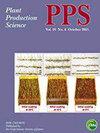Simplified estimation of branching plasticity of soybean cultivars in relation to planting density by branch development in the row with the gradient of distance between plants and after pinching
IF 1.3
3区 农林科学
Q2 AGRONOMY
引用次数: 0
Abstract
ABSTRACT The branching plasticity of soybean, i.e. its ability to adjust branch development to planting density, differs among cultivars. Field experiments are required to measure the degree of branching plasticity, but such experiments require a great deal of time and labor, and it is difficult to analyze and compare a large number of cultivars. A simple evaluation method needs to be established to investigate branching plasticity for a wide range of materials. Therefore, we conducted two methods to estimate this value. In the first method, we investigated the relationship between the number of branching nodes and intra-row planting distance with a gradient of distance between plants (5, 7.5, 10, 15, 20, 25, and 30 cm). The slope of the regression line between these two factors revealed significant differences among soybean cultivars, and was correlated with the measured values of branching plasticity determined in field experiments in 2015 and 2017. In the second method, the top of the stem was pinched out between the first and second leaf nodes at the V4 stage, and then the number of branch nodes was counted at maturity. There were differences in the number of branching nodes among cultivars, and a significant positive correlation between these values and the branching plasticity values measured in the 2015 and 2017 field experiments. Considering the time and effort required for field management and morphological surveys, the pinching method is considered to be an effective and simple method to evaluate branching plasticity. GRAPHICAL ABSTRACT大豆品种枝条可塑性与种植密度关系的简化估算——通过株间距离梯度和摘心后的枝条发育
大豆的分枝可塑性,即其根据种植密度调整分枝发育的能力,因品种而异。需要进行田间实验来测量分枝可塑性的程度,但这样的实验需要大量的时间和劳动力,并且很难分析和比较大量的品种。需要建立一种简单的评估方法来研究各种材料的分支塑性。因此,我们采用了两种方法来估计该值。在第一种方法中,我们研究了分枝节点数量与行内种植距离之间的关系,以及植物之间的距离梯度(5、7.5、10、15、20、25和30 cm)。这两个因素之间的回归线斜率显示了大豆品种之间的显著差异,并与2015年和2017年田间试验中确定的分枝可塑性测量值相关。在第二种方法中,在V4阶段将茎的顶部夹在第一和第二叶节之间,然后在成熟时计算分枝节的数量。不同品种的分枝节数存在差异,这些值与2015年和2017年田间试验测得的分枝可塑性值之间存在显著正相关。考虑到田间管理和形态调查所需的时间和精力,夹点法被认为是评估分枝可塑性的一种有效而简单的方法。图形摘要
本文章由计算机程序翻译,如有差异,请以英文原文为准。
求助全文
约1分钟内获得全文
求助全文
来源期刊

Plant Production Science
农林科学-农艺学
CiteScore
5.10
自引率
4.00%
发文量
27
审稿时长
>36 weeks
期刊介绍:
Plant Production Science publishes original research reports on field crops and resource plants, their production and related subjects, covering a wide range of sciences; physiology, biotechnology, morphology, ecology, cropping system, production technology and post harvest management. Studies on plant production with special attention to resource management and the environment are also welcome. Field surveys on cropping or farming system are also accepted. Articles with a background in other research areas such as soil science, meteorology, biometry, product process and plant protection will be accepted as long as they are significantly related to plant production.
 求助内容:
求助内容: 应助结果提醒方式:
应助结果提醒方式:


